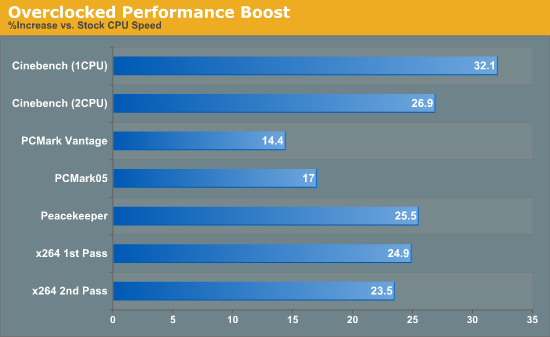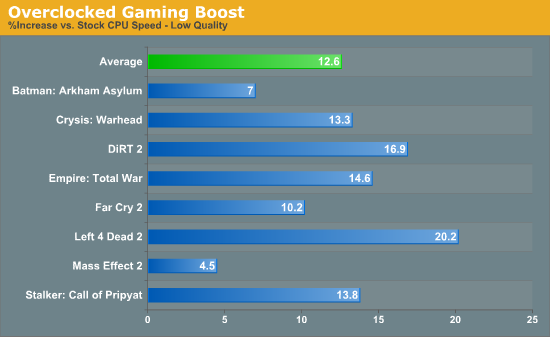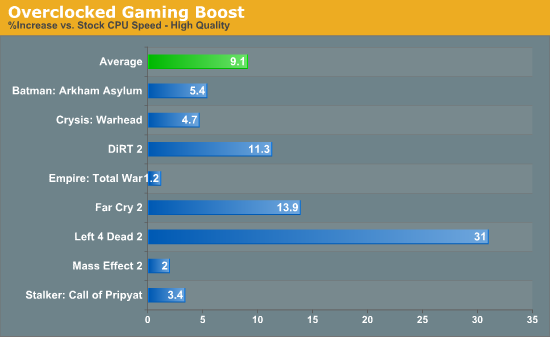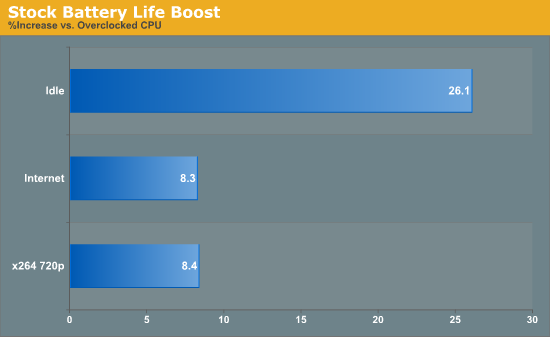Alienware M11x: World’s Smallest Gaming Laptop
by Jarred Walton on March 30, 2010 8:16 AM ESTPerformance Preview: Does Overclocking Matter?
Before we get to the actual benchmark results, we thought we'd begin by trying to answer an interesting question. The Alienware M11x—like the ASUS UL series—uses a CULV processor that runs at 1.3GHz by default. We've already done a CULV roundup and came away quite impressed with the platform. CULV laptops can last almost as long as Atom netbooks, and they manage to provide upwards of twice the performance for less than twice the price. The M11x bumps the CULV price up quite a bit, but it adds a potent GPU and allows you to overclock the CPU to 1.73GHz. It does this by raising the FSB from the default 800MHz to 1066MHz (200 base speed to 266 base), just like the ASUS UL series. Curious about how much a 33% overclock gets you? So were we, so we thought we'd begin with a look at the performance increase compared to the stock speed. We'll start with our standard application tests, which are the most likely to show a near-linear increase.

PCMark shows roughly a 15% increase, which is about right considering the HDD and GPU are part of the equation for those suites. Peacekeeper is far more of a CPU specific test, and it shows a 25% increase in performance from the overclock. Cinebench and x264 encoding are both very stressful CPU tests, and again we see very good scaling with clock speed: a 33% higher CPU clock results in 23 to 32% more performance. It's interesting that the single CPU Cinebench result shows a near linear increase with CPU clock speed while the other CPU intensive tests are closer to a 25% increase. More on this in a moment.
Next up let's look at how much gaming performance improves with overclocking. For these tests, we've run two scenarios: we tested the games at the minimum detail settings as well as "high" detail settings. How much of a bottleneck is the CULV processor? Would a faster CPU allow the GT335M to stretch its legs? Let's find out….


The lack of scaling with most of the games is a bit surprising. We figured the GT335M would need a lot more than a CULV processor to hit its stride, but overall the CPU doesn't appear to be a major bottleneck. At lower detail settings, the 33% overclock averages a 12.5% performance increase, with Left 4 Dead 2 showing the largest improvement. Higher detail settings moves the bottleneck more to the GPU in most titles, so the average increase is less than 10%. There are exceptions to the rule, of course, and this time Left 4 Dead 2 shows nearly linear scaling. It may be that the extra particle effects and geometry are to blame, but there is a definite difference and the game goes from 33FPS to 44FPS. Also note that in some of the benchmarks, we are using built-in performance tools that often score a bit higher than what players actually see in real gameplay.
But why aren't we seeing better scaling? Despite what Alienware states on their web pages, according to CPU-Z (and the benchmarks) the overclocked CPU isn't actually running at 1.73GHz. CPU-Z always reported a CPU speed of 1.60GHz when overclocked (266MHz bus with a 6x multiplier) whereas the multiplier is 6.5x (1.30GHz) at the stock bus speed. Perhaps Alienware is limiting the overclock slightly to keep heat output in check, which would explain why most of the gaming results didn't increase quite as much as we had hoped. If the CPU is indeed running at 1.6GHz instead of 1.73GHz, the overclock is only 23% instead of 33%. Even if the overclock isn't quite as high as advertised, though, it's still definitely good for performance.
But what about drawbacks from overclocking? How much battery life, for example, do users lose by running the CPU at a higher clock speed? We tested battery life (with the IGP enabled and the GT335M disabled) at both stock and overclocked settings. Below is the increase in battery life users can get by running the CPU at stock speed.

In low usage scenarios (idle or doing simple office tasks), the overclocked CPU sucks down quite a bit more power. In that case it might be worthwhile to disable the overclock, as 26% more battery life is very significant. In more demanding tasks like surfing the Internet and watching movies, running the CPU at stock doesn't help as much. The reason idle scenarios benefit so much is because the M11x doesn't allow dynamic frequency switching (SpeedStep) when the CPU is overclocked, so it runs at a constant 1.60GHz—twice as fast as the 800MHz speed the CPU sits at when idle and not overclocked. Still, since enabling/disabling the overclock requires a full reboot along with entering the BIOS to change the setting, we'd guess most users will simply leave the system overclocked and not worry about it. In our worst-case battery life test (x264 playback), the M11x delivers upwards of four hours of playback time, and the Internet test lasts over six hours; you'll really need all-day mobility before battery life becomes a major concern.
Now that we've given an overview of what happens with overclocking, let's get to the actual benchmark results. We'll report the best-case result for all of the tests, which means we ran the M11x overclocked for the application and gaming benchmarks, and for battery life tests we disabled the GT335M and ran the CPU at stock speed.










47 Comments
View All Comments
JarredWalton - Tuesday, March 30, 2010 - link
Hi everyone,In case you have any questions for me, I'm very likely not going to be able to respond for a few days. My wife is in labor, and I'll be heading out shortly, so wish us luck! Hope you enjoy the M11x review!
Cheers,
Jarred Walton
Lunyone - Tuesday, March 30, 2010 - link
Good luck! Hope all goes well with mom and kid. Hope that they both are healthy and I'll officially welcome you to parenthood! Lot's of work and sleepless nights, but well worth it, IMHO!JarredWalton - Wednesday, March 31, 2010 - link
Corbin Derrik Walton was born yesterday (March 30) at 2:33PM PDT.Mom and baby are doing fine, and we had a great experience. We used a midwife and delivered at the local birthing center, and after having my first daughter delivered in a hospital I have to say that this was an awesome change--much more intimate and relaxed, and the birthing tub was extremely helpful!
This is my second child, but Becky (my new wife's) first, and she was amazing! After around eight hours of labor, she gave birth au natural to our gigantic baby boy: 10 pounds, 4 ounces, and 21.5 inches long! We're back home, I managed to get some sleep for the first time in two days, and mom is trying to do likewise (with less success of course, since there's a big little boy wanting food on a regular basis).
Thanks for the well wishes, and thanks for the comments... I'll have to look through them in detail later.
--Jarred
Matt Campbell - Tuesday, March 30, 2010 - link
Congratulations Jarred! Great news :)therealnickdanger - Tuesday, March 30, 2010 - link
On the "baby and stuff":Congratulations and God bless!
On the article:
Very nice, I'm happy that you pointed out the lack of Optimus, Arrandale CULV, and driver issues. Even if the MX11 was $500, I would still hesitate given the potential for the MX11 mark 2. I was very excited for the MX11 after CES... then what seemed like only a month later I saw all the press surrounding Optimus and Arrandale CULV. Bad timing, indeed.
teko - Tuesday, March 30, 2010 - link
Good luck =)fabarati - Tuesday, March 30, 2010 - link
Congratulations Jarred!at80eighty - Tuesday, March 30, 2010 - link
Best wishes man! hope all goes smooth & happy!Voo - Tuesday, March 30, 2010 - link
All the best and don't worry about us! We'll just wait and bombard your mailbox with mails.. uh no that wasn't a threat, really ;)MonkeyPaw - Tuesday, March 30, 2010 - link
Hope your baby enjoys his/her new gaming notebook!